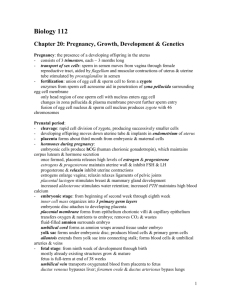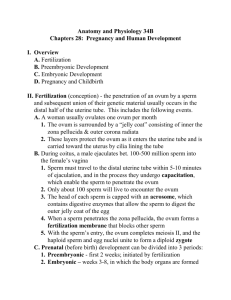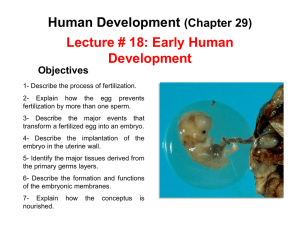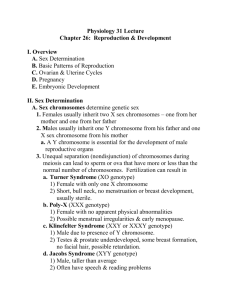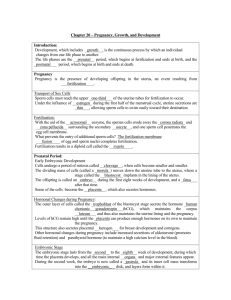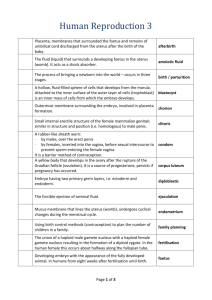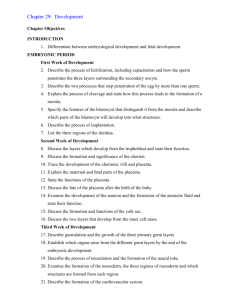I. Introduction
advertisement
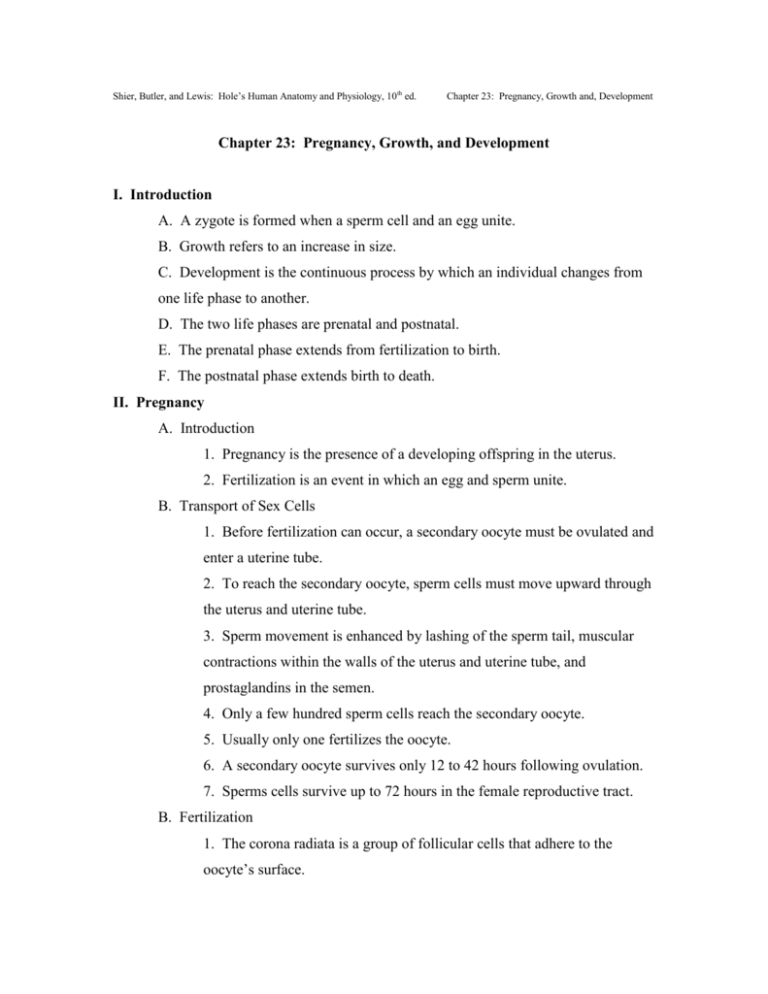
Shier, Butler, and Lewis: Hole’s Human Anatomy and Physiology, 10 th ed. Chapter 23: Pregnancy, Growth and, Development Chapter 23: Pregnancy, Growth, and Development I. Introduction A. A zygote is formed when a sperm cell and an egg unite. B. Growth refers to an increase in size. C. Development is the continuous process by which an individual changes from one life phase to another. D. The two life phases are prenatal and postnatal. E. The prenatal phase extends from fertilization to birth. F. The postnatal phase extends birth to death. II. Pregnancy A. Introduction 1. Pregnancy is the presence of a developing offspring in the uterus. 2. Fertilization is an event in which an egg and sperm unite. B. Transport of Sex Cells 1. Before fertilization can occur, a secondary oocyte must be ovulated and enter a uterine tube. 2. To reach the secondary oocyte, sperm cells must move upward through the uterus and uterine tube. 3. Sperm movement is enhanced by lashing of the sperm tail, muscular contractions within the walls of the uterus and uterine tube, and prostaglandins in the semen. 4. Only a few hundred sperm cells reach the secondary oocyte. 5. Usually only one fertilizes the oocyte. 6. A secondary oocyte survives only 12 to 42 hours following ovulation. 7. Sperms cells survive up to 72 hours in the female reproductive tract. B. Fertilization 1. The corona radiata is a group of follicular cells that adhere to the oocyte’s surface. 2. The zona pellucida is located around the oocyte’s membrane. 3. The function of an acrosome is to help the sperm penetrate the zona pellucida. 4. Some factors that reduce the chance that other sperm cells will penetrate the oocyte are hardening of the zona pellucida after fertilization and the unresponsiveness of the oocyte cell membrane to other sperm cells. 5. Once a sperm cell enters the oocyte’s cytoplasm, the secondary oocyte divides unequally to form a large cell and a tiny second polar body. 6. A zygote is the cell formed by the union of a sperm and egg. III. Prenatal Period A. Introduction 1. The prenatal period is from conception to birth. 2. The three periods of the prenatal period are period of cleavage, an embryonic stage, and a fetal stage. B. Period of Cleavage 1. The events of cleavage are rapid cell divisions and distribution of the zygote’s cytoplasm into progressively smaller cells. 2. Blastomeres are cells produced by cleavage. 3. A morula is a solid ball of about 16 cells that remain free in the uterine cavity for about 3 days. 4. A blastocyst is a hollow mass of cells that implants into the endometrium. 5. The two regions of cells of a blastocyst are an inner cell mass and a trophoblast. 6. The inner cell mass gives rise to the embryo proper. 7. The trophoblast gives rise to structures that assist the embryo. 8. The events of implantation are attachment of blastocyst to endometrium, digestion of portion of the endometrium, sinking of blastocyst into depression in endometrium, and the thickening of the endometrium around the blastocyst. 9. Implantation begins normally about the end of the first week of development and is complete during the second week of development. 10. The placenta is a vascular structure formed by the cells surrounding the embryo and cell of the endometrium and functions to attach the embryo to the uterine wall and to exchange nutrients, gases, and wastes between the maternal blood and the embryo’s blood. C. Hormonal Changes During Pregnancy 1. Following implantation, cells of the trophoblast secrete hCG. 2. The effects of hCG are to maintain the corpus luteum so it will continue to secrete estrogen and progesterone, and to inhibit the release of LH and FSH by the anterior pituitary. 3. The corpus luteum secretes estrogen and progesterone. 4. The placenta secretes placental estrogen and placental progesterone and placental lactogen. 5. The effects of estrogens and progesterone are to maintain the uterine wall, to help the mammary glands make milk, to inhibit secretion of LH and FSH, and to enlarge the vagina and external reproductive organs. 6. The effects of relaxin are to relax smooth muscle fibers in the uterus to prevent uterine contractions. It also relaxes pelvic ligaments. 7. The effects of placental lactogen are breast development. 8. The effects of aldosterone are to promote reabsorption of sodium that leads to water retention. 9. The effects of PTH are to maintain high concentration of maternal blood calcium. D. Other Changes During Pregnancy 1. The uterus eventually extends from the level of the 5th rib to the pelvic cavity. 2. The increase in size of the uterus puts pressure on abdominal organs, urinary bladder, and the diaphragm. 3. Other maternal factors that increase during pregnancy are blood volume, cardiac output, breathing rate, and urine production. E. Embryonic Stage 1. The embryonic stage extends from the beginning of the second week through the eighth week of prenatal development. 2. The events of the embryonic period include development of placenta, development of main internal organs and external body structures. 3. Primary germ layers are three layers of the embryonic disc and form during gastrulation. 4. A gastrula is an embryo that consists of three primary germ layers. 5. The connecting stalk is a structure that attaches the embryo to the developing placenta. 6. Gastrulation is the formation of three primary germ layers. 7. Endoderm gives rise to epithelial linings of the digestive tract, respiratory tract, urinary bladder, and urethra. 8. Mesoderm gives rise to muscle tissue, bond tissue, bone marrow, blood, blood vessels, lymphatic vessels, connective tissues, internal reproductive organs, kidneys, and the epithelial lining of the body cavities. 9. Ectoderm gives rise to the nervous system, portion so special sensory organs, the epidermis, hair nails, glands of the skin and linings of the mouth and anal canal. 10. The chorion is a two-layered structure that contains trophoblasts. 11. Chorionic villi are projections of the chorion into the endometrium of the uterus. 12. Lacunae are irregular spaces in the endometrium around and between the chorionic villi. 13. Major events of the fourth week of development are the flat embryonic disc becomes cylindrical, head and jaws appear, the heart beats and forces blood through blood vessels, and tiny buds form that will give rise to upper and lower limbs. 14. Major events of the fifth through seventh weeks of development are growth of the head, rounding of the head, development of eyes, nose, and mouth, elongation of upper and lower limbs, formation of fingers and toes, and establishment of all main internal organs. 15. Major events of the eighth week of development are enlargement of embryo, continued formation of chorionic villi and placenta. 16. The placental membrane is composed of the epithelium of the chorionic villus and the endothelium of the capillary inside the villus. 17. Substances that are exchanged across the placental membrane are oxygen, carbon dioxide, nutrients, and embryonic wastes. 18. The embryonic portion of the placenta is composed of parts of the chorion and its villi. 19. The maternal portion of the placenta is composed of the area of the uterine wall to which the villi are attached. 20. The amnion is a membrane that develops around the embryo. 21. The function of amniotic fluid is to cushion the developing embryo. 22. The umbilical cord is formed from the amnion enveloping the connecting stalk. 23. The three blood vessels found in the umbilical cord are two umbilical arteries and one umbilical vein. 24. The yolk sac is a structure attached to the underside of the embryo that gives rise to blood cells, sex cells, and portions of the digestive tract. 25. The allantois is a tube like structure that extends from the yolk sac into the connecting stalk. It gives rise to umbilical blood vessels. 26. The amniochorionic membrane is the fusion of the amnion and chorion. 27. The embryonic stage concludes at the end of the eighth week. 28. Teratogens are factors that cause malformations by affecting an embryo during its period of rapid growth and development. F. Fetal Stage 1. The fetal stage is the period that begins at the end of the eighth week and extends until birth. 2. The major events of the ninth through twelfth week of development are ossification centers appear in bones, sex organs differentiate, nerves and muscles coordinate so that the fetus can move its limbs. 3. The major events of the thirteenth through sixteenth week of development are rapid body growth and continuation of ossification. 4. The major events of the seventeenth through twentieth week of development are strengthening of muscles, covering of skin with lanugo and vernix caseosa. 5. The major events of the twenty-first through thirty-eighth week of development are weight gain, subcutaneous fat deposition, appearance of eyebrows and eyelashes, opening of eyelids, and descent of testes. G. Fetal Blood and Circulation 1. Fetal hemoglobin is different from maternal hemoglobin in that it has a higher affinity for oxygen. 2. The function of the umbilical vein is to transport blood rich in oxygen and nutrients from the placenta to the fetal body. 3. The function of the ductus venosus is to allow blood to bypass the liver. 4. The function of the foramen ovale is to allow blood to go directly from the right atrium to the left atrium. 5. The function of the ductus arteriosus is to allow blood to go directly from the pulmonary trunk to the aorta. 6. The function of the umbilical arteries is to transport blood from the embryo to the placenta. H. Birth Process 1. Uterine contractions are stimulated at the beginning of the birth process by declining levels of progesterone, thinning of cervix, and stretching of uterine and vaginal tissues. 2. The release of oxytocin is stimulated by the stretching of uterine and vaginal tissues. 3. The functions of oxytocin are to stimulate powerful uterine contractions. 4. Labor is said to be controlled by a positive feedback mechanism because an increase in oxytocin increases uterine contractions and an increase in uterine contractions increases oxytocin secretion. 5. Afterbirth is the expulsion of the placenta. 6. Involution is the shrinking of the uterus following the birth process. I. Milk Production and Secretion 1. Hormones that stimulate further development of breasts during pregnancy are estrogens and progesterone. 2. The actions of estrogens on the breasts are to cause the ductile system to grow and branch, and to deposit abundant fat around them. 3. The actions of progesterone on the breasts are to stimulate the development of the alveolar glands at the ends of ducts. 4. The actions of prolactin on the breasts are to stimulate the mammary glands to secrete large quantities of milk. 5. The actions of oxytocin on the breasts are to cause myoepithelial cells to contract in order to eject milk. 6. Colostrum a watery fluid secreted immediately after birth. It is rich in proteins and antibodies. 7. Myoepithelial cells are cells that surround alveolar glands and can contract in order to promote the ejection of milk from glands. 8. Mechanical stimulation of the nipples signals the release of oxytocin. 9. Inhibition of prolactin is triggered by not removing milk from mammary glands. 10. A woman who is breastfeeding generally does not ovulate because prolactin suppresses the release of LH and FSH. IV. Postnatal Period A. Introduction 1. The postnatal period extends birth until death. 2. The major divisions of the postnatal period are neonatal period, infancy, childhood, adolescence, adulthood, and senescence. B. Neonatal Period 1. The neonatal period extends from birth until the end of the first four weeks. 2. A newborn’s first breath is crucial because it has an immediate need for oxygen and to excrete carbon dioxide. 3. The first breath is forceful because the lungs are collapsed and the airways are small. Also, surface tension holds the moist membranes of the lungs together. 4. The metabolic rate of a newborn is high. 5. The liver of a newborn cannot supply sufficient glucose. 6. The newborn uses stored fat for energy. 7. The kidneys of a newborn are unable to concentrate urine. 8. A newborn is susceptible to dehydration because the kidneys cannot concentrate urine. 9. Body temperature is unstable in a newborn because homeostatic control mechanisms may not function adequately. 10. The cardiovascular adjustments of the newborn are constriction of umbilical blood vessels, ductus arteriosis, and ductus venosus, and closing of the foramen ovale. C. Infancy 1. Infancy is the period from the end of the neonatal period to one year of age. 2. Major events of infancy are maturation of muscular and nervous systems, communication begins, rapid growth. D. Childhood 1. Childhood is the period from the end of year one to puberty. 2. Major events of childhood are rapid growth, development of muscular control, and establishment of bladder and bowel control. E. Adolescence 1. Adolescence is the period from puberty to adulthood. 2. Major events of adolescence are physiological and anatomical changes that result in a reproductively functional individual, development of high levels of motor skills and intellectual abilities, and continuation of emotional maturity. F. Adulthood 1. Adulthood is the period from adolescence to old age. 2. By the third decade, obvious signs of aging are some hearing loss, thickening of heart muscle, and loss of elasticity of ligaments. 3. In the fourth decade, developmental changes are weight gain, loss of hair, gray hairs, visual problems, loss of skeletal muscle strength, decline of immune system, development of wrinkles, and narrowing or arteries. 4. The developmental changes during the fifth decade are slow nail growth, decline of taste buds, visual problems, hearing problems, loss of elasticity of skin, and menopause. 5. Developmental changes during the sixth decade are memory loss and continued sagging of skin. G. Senescence 1. Senescence is the process of growing old. 2. Senescence is the result of the normal wear-and-tear of body parts over many years. 3. Major events of senescence include loss of memory and intellectual functions, loss of coordination and sensory functions, and decreased immune responses. 4. Death usually results from mechanical disturbances in the cardiovascular system or from disease processes that affect vital organs. V. Aging A. Introduction 1. Aging is difficult to analyze because of the intricate interactions of the body’s organ systems. 2. Gerontology is the study of biological changes of aging at the molecular, cellular, organismal, and population levels. B. Passive Aging 1. Passive aging entails breakdown of structures and slowing of functions. 2. At the molecular level, passive aging is seen in the degeneration of the elastin and collagen proteins of connective tissues, causing skin to sag and muscle to lose its firmness. 3. A free radical is a molecule that has an unpaired electron in its outermost shell. 4. The role of free radicals in aging is to kill cells. C. Active Aging 1. Active signs of aging are lipofuscin granules and autoimmunity. 2. Apoptosis is programmed cell death. D. The Human Life Span 1. The human life span is the length of time that a human can theoretically live. 2. Life expectancy is a realistic projection of how long an individual will live. 3. Life expectancy approaches life span as technology conquers diseases. 4. Life expectancy had increased because of medical advances.
